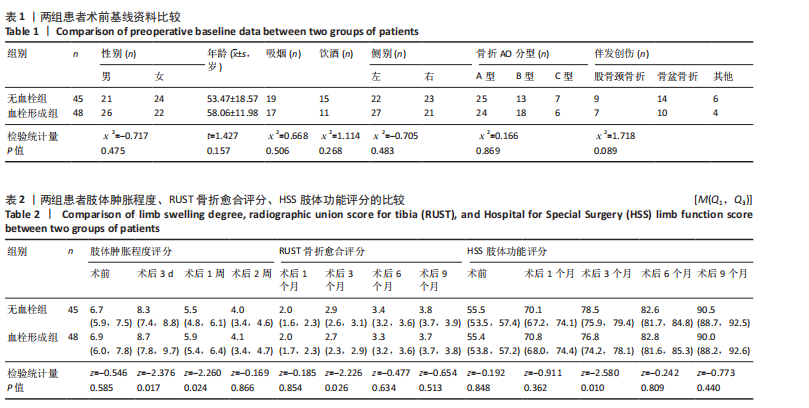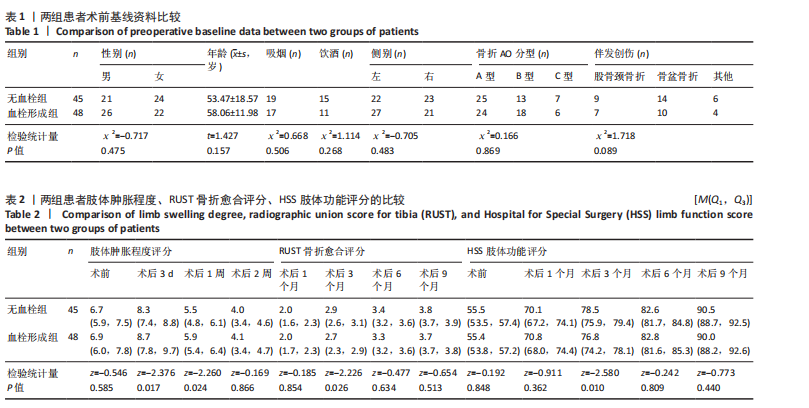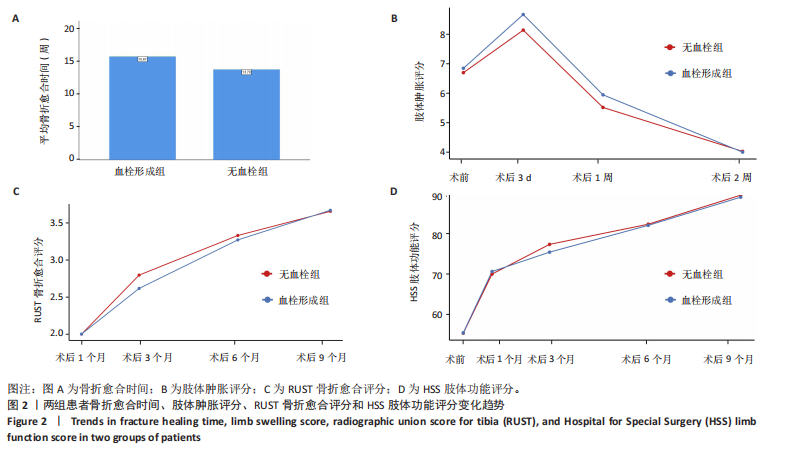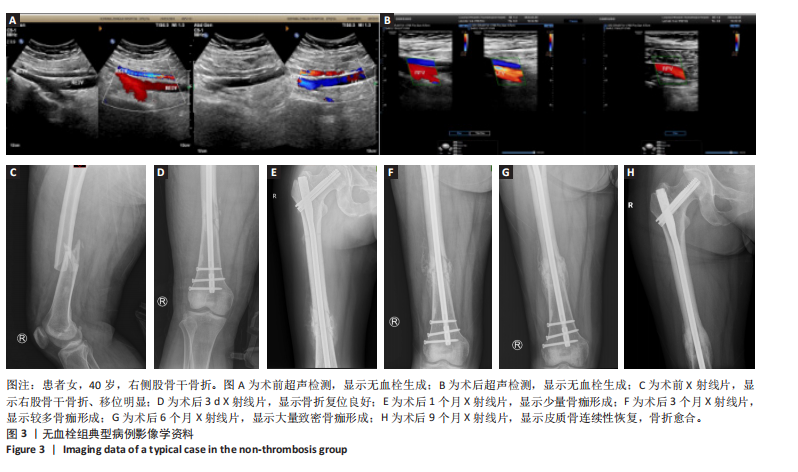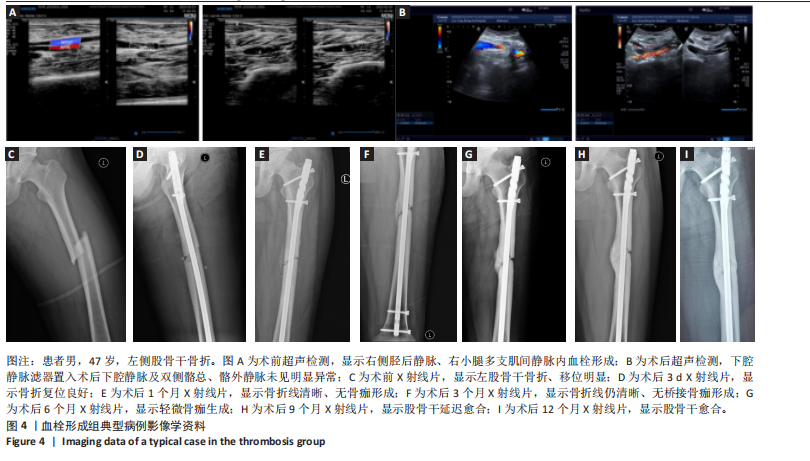[1] 王永刚,付凯,郑伟,等.老年股骨颈骨折围术期下肢深静脉血栓形成危险因素分析[J].中国修复重建外科杂志,2024,38(11):1336-1339.
[2] MAO C, XIONG Y, FAN C. Comparison between thromboelastography and conventional coagulation assays in patients with deep vein thrombosis. Clin Chim Acta. 2021;520:208-213.
[3] 周泽霖,陈松海,陈韵龙,等.低分子量肝素对比其他抗凝药物预防脊柱脊髓损伤后静脉栓塞症疗效及安全性的Meta分析[J].中国脊柱脊髓杂志,2023,33(1):51-61.
[4] 唐一仑,徐燕,张笑,等.低分子肝素联合阿司匹林预防脾破裂并下肢骨折患者围术期静脉血栓形成[J].中国修复重建外科杂志, 2022,36(11):1381-1387.
[5] 赵纪春,邱贵兴,裴福兴,等.骨科大手术加速康复围手术期静脉血栓栓塞症防治专家共识[J].中华骨与关节外科杂志,2022,15(10): 754-762.
[6] LI Y, LIU L, LI S, et al. Impaired bone healing by enoxaparin via inhibiting the differentiation of bone marrow mesenchymal stem cells towards osteoblasts. J Bone Miner Metab. 2022;40(1):9-19.
[7] BUTLER AJ, EISMONT FJ. Effects of Anticoagulant Medication on Bone-Healing. JBJS Rev. 2021;9(5):e20.00194.
[8] HANDSCHIN AE, TRENTZ OA, HOERSTRUP SP, et al. Effect of low molecular weight heparin (dalteparin) and fondaparinux (Arixtra) on human osteoblasts in vitro. Br J Surg. 2005;92(2):177-183.
[9] DEMIRTAS A, AZBOY I, BULUT M, et al. Investigation of the effects of Enoxaparin, Fondaparinux, and Rivaroxaban used in thromboembolism prophylaxis on fracture healing in rats. Eur Rev Med Pharmacol Sci. 2013;17(14):1850-1856.
[10] 孙传兴.临床疾病诊断依据治愈好转标准[M].2版.北京:人民军医出版社,2002:381.
[11] 张福先,王深明.静脉血栓栓塞症诊断与治疗[M].北京:人民卫生出版社,2013:99-104.
[12] 韩云,贾飞飞,鹿青,等.老年髋部骨折患者围术期下肢深静脉血栓基础预防专家共识(2024版)[J].中华创伤杂志,2024,40(9):769-780.
[13] 国家中医药管理局.中医病证诊断疗效标准[S].南京:南京大学出版社,1994:145-146.
[14] PANCHOO P, LAUBSCHER M, HELD M, et al. Radiographic union score for tibia (RUST) scoring system in adult diaphyseal femoral fractures treated with intramedullary nailing: an assessment of interobserver and intraobserver reliability. Eur J Orthop Surg Traumatol. 2022;32(8): 1555-1559.
[15] MAROM N, XIANG W, HEATH M, et al. Time interval affects physical activity scores: a comparison of the Marx Activity Rating Scale and the Hospital for Special Surgery Pediatric Functional Activity Brief Scale. Knee Surg Sports Traumatol Arthrosc. 2020;28(8):2619-2625.
[16] WALTER N, SZYMSKI D, KURTZ SM, et al. Femoral shaft fractures in eldery patients - An epidemiological risk analysis of incidence, mortality and complications. Injury. 2023;54(7):110822.
[17] WALTER N, SZYMSKI D, KURTZ S, et al. Factors associated with mortality after proximal femoral fracture. J Orthop Traumatol. 2023;24(1):31.
[18] LO FARO V, JOHANSSON T, HÖGLUND J, et al. Polygenic risk scores and risk stratification in deep vein thrombosis. Thromb Res. 2023;228:151-162.
[19] KHOSLA A, ZHAO Y, MOJIBIAN H, et al. High-Risk Pulmonary Embolism: Management for the Intensivist. J Intensive Care Med. 2023;38(12): 1087-1098.
[20] 马亚青,黄伸伸,毛毅敏,等.中高危急性肺栓塞临床恶化影响因素分析[J].郑州大学学报(医学版),2025,60(1):83-86.
[21] LIU X, PANG P, LUO Z, et al. Prevalence and risk factors for proximal deep vein thrombosis at admission in patients with traumatic fractures: a multicenter retrospective study. Front Cardiovasc Med. 2024;11:1372268.
[22] SHI D, BAO B, ZHENG X, et al. Risk factors for deep vein thrombosis in patients with pelvic or lower-extremity fractures in the emergency intensive care unit. Front Surg. 2023;10:1115920.
[23] HOGWOOD J, MULLOY B, LEVER R, et al. Pharmacology of Heparin and Related Drugs: An Update. Pharmacol Rev. 2023;75(2):328-379.
[24] ZHOU H, YE LL, ZHOU JT, et al. Direct oral anticoagulants (DOACs) versus low-molecular-weight heparin (LMWH) for extended thromboprophylaxis following major abdominal/pelvic cancer-related surgery: a systematic review and meta-analysis. Surg Endosc. 2024;38(3):1131-1138.
[25] GEERTS WH, HEIT JA, CLAGETT GP, et al. Prevention of venous thromboembolism. Chest. 2001;119(1 Suppl):132S-175S.
[26] SHAH S, NAYFEH T, HASAN B, et al. Perioperative Management of Vitamin K Antagonists and Direct Oral Anticoagulants: A Systematic Review and Meta-analysis. Chest. 2023;163(5):1245-1257.
[27] POZZI A, LUCÀ F, GELSOMINO S, et al. Coagulation Tests and Reversal Agents in Patients Treated with Oral Anticoagulants: The Challenging Scenarios of Life-Threatening Bleeding and Unplanned Invasive Procedures. J Clin Med. 2024;13(9):2451.
[28] GROTTKE O, AFSHARI A, AHMED A, et al. Clinical guideline on reversal of direct oral anticoagulants in patients with life threatening bleeding. Eur J Anaesthesiol. 2024;41(5):327-350.
[29] O’HARA NN, O’TOOLE RV, FREY KP, et al. Risk-stratified thromboprophylaxis effects of aspirin versus low-molecular-weight heparin in orthopedic trauma patients: A secondary analysis of the PREVENT CLOT trial. J Trauma Acute Care Surg. 2024;96(4):573-582.
[30] MAJOR EXTREMITY TRAUMA RESEARCH CONSORTIUM (METRC), O’TOOLE RV, STEIN DM, et al. Aspirin or Low-Molecular-Weight Heparin for Thromboprophylaxis after a Fracture. N Engl J Med. 2023; 388(3):203-213.
[31] SARTORI M, IOTTI M, CAMPORESE G, et al. Six-week low-molecular-weight heparin versus 12-week warfarin for calf deep vein thrombosis: A randomized, prospective, open-label study. Am J Hematol. 2024; 99(5):854-861.
[32] YONG BSJ, LING RR, LI R, et al. Pharmacotherapy for Venous Thromboprophylaxis following Total Hip or Knee Arthroplasty: A Systematic Review and Network Meta-analysis. Semin Thromb Hemost. 2025;51(3):290-300.
[33] TEICHMAN AL, COTTON BA, BYRNE J, et al. Approaches for optimizing venous thromboembolism prevention in injured patients: Findings from the consensus conference to implement optimal venous thromboembolism prophylaxis in trauma. J Trauma Acute Care Surg. 2023;94(3):469-478.
[34] PANDA S, GAUTAM V, MITRA S, et al. Low-molecular-weight heparin salvage in pedicled flap reconstruction in head and neck: a prospective cohort study. J Laryngol Otol. 2024;138(8):852-857.
[35] KATZIR A, FISHER-NEGEV T, OR O, et al. Is It Safe to Resume Direct Oral Anticoagulants upon Discharge after Hip Fracture Surgery? A Retrospective Study. J Clin Med. 2023;13(1):17.
[36] WALTON KJ, DUNCAN JM, DESCHAMPS P, et al. Heparin acts synergistically with interleukin-11 to induce STAT3 activation and in vitro osteoclast formation. Blood. 2002;100(7):2530-2536.
[37] STREET JT, MCGRATH M, O’REGAN K, et al. Thromboprophylaxis using a low molecular weight heparin delays fracture repair. Clin Orthop Relat Res. 2000;(381):278-289.
[38] TAN L, QI B, YU T, et al. Incidence and risk factors for venous thromboembolism following surgical treatment of fractures below the hip: a meta-analysis. Int Wound J. 2016;13(6):1359-1371.
[39] 王俊臣.探讨低分子量肝素钙预防老年下肢骨折术后下肢深静脉血栓形成的效果[J].中国实用医药,2020,15(31):131-132.
[40] 张印,叶向阳,乔宗瑞.逐瘀生骨汤联合低分子肝素钙对髋关节置换患者功能恢复、血液流变学、深静脉血栓形成的影响[J].广州中医药大学学报,2023,40(4):859-864.
[41] 臧加成,马信龙,杨爽,等.银杏叶提取物联合低分子肝素预防骨折患者DVT发生的临床疗效分析[J].哈尔滨医科大学学报,2024, 58(4):411-415.
[42] 丁志辉,周铨昆,余征,等.田七祛瘀胶囊联合低分子量肝素预防老年股骨转子间骨折术后下肢深静脉血栓形成的效果观察[J].江西中医药大学学报,2021,33(1):42-44.
[43] 胡钢,严松鹤,俞云飞,等.补气活血通络汤联合低分子量肝素对气虚血瘀型老年髋部骨折患者血栓前状态的疗效观察[J].南京中医药大学学报,2021,37(1):31-35.
[44] 唐贵菊,田塬,王继婷,等.中药注射液联合低分子量肝素预防骨科术后深静脉血栓形成的网状Meta分析[J].中草药,2021,52(14): 4289-4306.
[45] 李启义,张江涛,常守亚.益气活血通络汤与低分子量肝素抗凝对大鼠骨折愈合、血液流变学及TGF-β1表达的影响[J].中国老年学杂志,2024,44(4):972-976.
[46] 倘艳锋,郭超韡,石腾博,等.益气活血通络汤联合低剂量低分子量肝素预防深静脉血栓形成的疗效分析[J].中华中医药杂志,2024, 39(8):4505-4508. |
